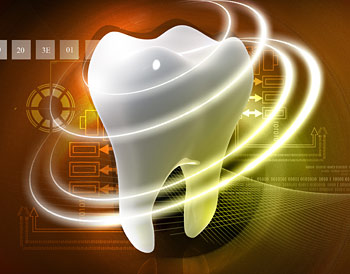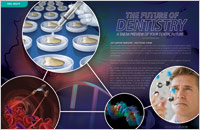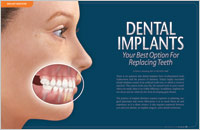 There’s no disputing the fact that we’re living in a world driven by technology. Today, most of us rely on an array of devices designed to make our lives easier from the microwave ovens in our kitchens to the cell phones in our pockets.
There’s no disputing the fact that we’re living in a world driven by technology. Today, most of us rely on an array of devices designed to make our lives easier from the microwave ovens in our kitchens to the cell phones in our pockets.
Dentistry has also advanced at an incredible rate over the past few years. Today, dentists the world over are tapping into some amazing technology to help them provide their patients with dental procedures that are done quickly, efficiently, and with little or no discomfort. At the office of Dr. Christian Johnson, we fully embrace the latest, state-of-the-art dental technologies so we can provide our patients with the most efficient, comfortable, and convenient dental treatment they deserve.
Below are some of the latest examples of new and improved dental technologies that are in widespread use at dental practices across the U.S. and beyond.
- Air Abrasion Technology: Of all the latest available dental technologies, the one that tends to get dentists excited the most is air abrasion technology. This technology involves using an air-powered device to remove small amounts of plaque and decay from teeth without patients having to endure the bothersome sounds and vibrations of the conventional dental drill. Air abrasion uses a powerful, tiny stream of air to blast away material from the teeth.
- Anesthesia Wand: A dental anesthesia wand is a remarkable device that replaces the traditional syringe. This device allows dentists to provide pain-free and stress-free anesthesia to their patients. The wand can be used to numb a single tooth or an entire area, often without residual numbness in the tongue and lips.
- CAD/CAM Same-Day Crowns: Thanks to CAD/CAM same-day crown technology, patients no longer have to wait several weeks to have permanent crowns placed on their teeth. This technology combines 3D imaging and computer-aided design & manufacturing technology to give dentists the ability to place permanent crowns in one convenient appointment.
- Cone Beam CT Imaging: Cone beam imaging in dentistry is transforming the manner in which dentists go about gathering information about their patients’ oral health. Unlike traditional X-rays, cone beam 3D images are converted into three-dimensional views that can be manipulated by computer software to provide virtual 3D models of the mouth. These models are used to detect problems, plan procedures, and visualize internal structures for more effective treatment.
 Dental Implants: Considered the “gold standard” in tooth replacement, a dental implant is a small titanium post that is surgically placed in the jawbone to replace a missing tooth root. Once the implant has been put into place and a healing process is complete, a realistic dental crown is placed on top of the implant for a tooth replacement that looks, feels, and functions just like a natural tooth.
Dental Implants: Considered the “gold standard” in tooth replacement, a dental implant is a small titanium post that is surgically placed in the jawbone to replace a missing tooth root. Once the implant has been put into place and a healing process is complete, a realistic dental crown is placed on top of the implant for a tooth replacement that looks, feels, and functions just like a natural tooth.
- Digital Dental Impressions: Instead of having to endure messy and uncomfortable putty impressions, patients can now have digital dental impressions taken of their teeth. Once the teeth have been “dusted” with a fine reflective powder, an intraoral wand is inserted into the patient’s mouth to capture digital scans of the teeth which are displayed on a chairside monitor. The digital impressions can be used to assess the condition of teeth and to fabricate dental restorations.
- Digital X-Rays: While X-rays have long been used as diagnostic tools in dentistry, digital technology has made dental X-rays safer and more useful. Digital X-rays greatly reduce radiation exposure and produce sharp images that can be enhanced to show detail for more effective diagnosis and treatment.
- Intra-Oral Camera: A picture is worth… plenty, when it comes to helping you understand your dental examination, diagnosis and treatment! With these tiny cameras, you can see what the dentist sees, on a small chair-side monitor. The images of your teeth can be saved as stills or video — or even printed out — so you can see exactly what's happening in your mouth.
- Laser Diagnosis and Treatment: Today dentists are using lasers to detect small areas of tooth decay, to treat gum disease, and to remove cancerous cells in the mouth. Many dentists are even using lasers to perform gum surgery and to treat cavities.
Contact Your Waldorf, MD Dentist
Every modern dental practice today relies on dental technology, and our practice is no exception. Dr. Johnson and his team strive to keep pace with all the latest technological advances so we can provide the most efficient and comfortable dental treatment to the patients we serve. If you have any questions about the dental technology we use at our office, please feel free to contact us for the answers you need!
Related Articles

The Future Of Dentistry
Can you imagine the day your dentist actually grows you a new tooth to replace one that has been lost? Can you conceive of the day when dentists protect babies from tooth decay before they even have teeth? Learn more about these exciting innovations — they're closer than you think... Read Article

Dental Implants – Your Best Option For Replacing Teeth
Dental implants have many advantages over older methods of tooth replacement like bridges and dentures — from the way they function and feel to the way they look and last. Vigorous research has documented and confirmed that in the right situations, dental implant success rates are over 95%. It is no exaggeration to say that they have revolutionized dentistry. They may even change your life... Read Article